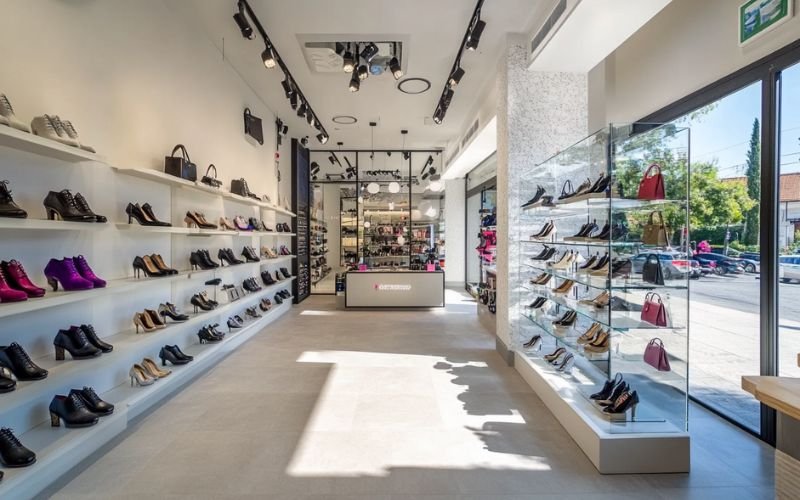Opening a shoe store can be an exciting and rewarding venture, especially if you have a passion for fashion, retail, and entrepreneurship. The global footwear market is booming, with an estimated value of $530.3 billion by 2027. Whether you’re interested in selling luxury heels, athletic sneakers, or eco-friendly footwear, there’s a niche waiting for you to fill. This comprehensive guide will walk you through every step of the process, from planning and funding to marketing and operations, ensuring your shoe store is set up for long-term success.
Why Start a Shoe Store?
The footwear industry offers consistent demand, diverse customer segments, and opportunities for creativity and profitability. Here are some compelling reasons to consider starting a shoe store:
- Consistent Demand: Shoes are a necessity, with people purchasing footwear for work, leisure, sports, and special occasions.
- Diverse Market Segments: From kids’ shoes to high-end designer footwear, there’s a niche for every entrepreneur.
- High Profit Margins: Shoe stores often achieve profit margins between 25% and 50%, depending on the product mix and business model.
- Sustainability Trends: The demand for eco-friendly and sustainable footwear is growing, offering a unique opportunity to stand out.
Now, let’s dive into the step-by-step process of opening a successful shoe store.

Step 1: Conduct Market Research
Market research is the foundation of any successful business. It helps you understand your target audience, identify market gaps, and analyze competitors. Here’s how to get started:
Analyze Industry Trends
- The U.S. footwear market reached $61.1 billion in 2023 and continues to grow.
- Online shoe sales are booming, with platforms like Amazon and Zappos leading the charge.
- Sustainability and customization are key trends, with consumers seeking eco-friendly and personalized options.
Identify Your Target Audience
- Who are your ideal customers? Consider demographics like age, gender, lifestyle, and income level.
- For example, if you’re targeting professionals, focus on stylish yet comfortable work shoes. If your audience is younger, athletic sneakers or trendy streetwear might be more appealing.
Study Competitors
- Visit local shoe stores and analyze their product offerings, pricing, and customer service.
- Research online competitors to understand their strengths and weaknesses.
- Look for gaps in the market, such as a lack of eco-friendly or niche footwear options.

Step 2: Choose Your Niche
Selecting a niche helps differentiate your store and attract a loyal customer base. Here are some popular niches to consider:
- Athletic Shoes: Focus on performance footwear for running, basketball, or hiking.
- Luxury Shoes: Offer high-end, designer footwear for fashion-conscious shoppers.
- Children’s Shoes: Cater to parents looking for durable and stylish options for kids.
- Eco-Friendly Footwear: Sell sustainable shoes made from recycled or organic materials.
- Custom Shoes: Provide personalized designs for customers seeking unique footwear.
Your niche will influence everything from your branding to your inventory, so choose wisely.
Step 3: Write a Business Plan
A well-crafted business plan serves as your roadmap to success. It’s also essential if you plan to secure funding from investors or lenders. Include the following sections:
- Executive Summary: A brief overview of your business concept, target market, and goals.
- Market Analysis: Insights into industry trends, target audience, and competitors.
- Product Line: Details about the types of shoes and accessories you’ll sell.
- Marketing Strategy: How you’ll attract and retain customers through advertising, social media, and promotions.
- Financial Plan: Startup costs, revenue projections, and funding requirements.

Step 4: Secure Funding
Starting a shoe store requires an initial investment for inventory, store setup, marketing, and more. Here are some funding options:
- Personal Savings: Use your own funds to maintain full control of your business.
- Small Business Loans: Apply for loans through banks or the Small Business Administration (SBA).
- Investors: Pitch your business plan to investors in exchange for equity.
- Crowdfunding: Platforms like Kickstarter can help raise funds while building brand awareness.
Estimated Startup Costs
- Inventory: 50,000
- Store Setup: 30,000
- Marketing: 10,000
- Licenses and Permits: 1,000
Step 5: Find the Perfect Location
The location of your shoe store can make or break your business. Look for a high-traffic area with your target demographics. Here are some tips:
- Shopping Malls: Ideal for attracting a diverse range of customers.
- Downtown Areas: Great for boutique or luxury shoe stores.
- Near Schools or Gyms: Perfect for athletic or children’s footwear.
Ensure the space has enough room for inventory storage, a comfortable shopping area, and fitting zones.
Step 6: Register Your Business and Obtain Licenses
To operate legally, you’ll need to register your business and secure the necessary permits. Here’s what you’ll need:
- Business Structure: Choose between a sole proprietorship, LLC, or corporation.
- Employer Identification Number (EIN): Obtain this from the IRS for tax purposes.
- Business License: Check local requirements for retail businesses.
- Sales Tax Permit: Register with your state to collect sales tax.
Step 7: Design Your Store Layout
An inviting store layout enhances the shopping experience and encourages purchases. Focus on:
- Visual Merchandising: Use attractive displays to showcase your bestsellers.
- Comfortable Fitting Areas: Provide seating and mirrors for customers to try on shoes.
- Organized Sections: Group products by category, brand, or size for easy navigation.
Step 8: Build Relationships with Suppliers
Reliable suppliers are crucial for maintaining a diverse and high-quality inventory. Here’s how to find them:
- Attend Trade Shows: Events like FN Platform connect retailers with footwear manufacturers.
- Research Online: Platforms like Alibaba and Faire offer wholesale options.
- Negotiate Terms: Secure favorable pricing, payment terms, and delivery schedules.
Step 9: Create an Online Store
In today’s digital age, having an e-commerce presence is essential. Use platforms like Shopify, WooCommerce, or BigCommerce to set up your online store. Include:
- High-Quality Photos: Showcase your products with professional images.
- Detailed Descriptions: Highlight features like materials, sizes, and care instructions.
- Customer Reviews: Build trust by displaying testimonials and ratings.
Step 10: Market Your Shoe Store
Effective marketing drives foot traffic and online sales. Here are some strategies:
- Social Media Marketing: Use Instagram and TikTok to showcase new arrivals and promotions.
- Email Campaigns: Send newsletters with exclusive discounts and updates.
- Local Advertising: Distribute flyers or partner with nearby businesses.
- Influencer Collaborations: Work with fashion influencers to promote your brand.
Step 11: Hire and Train Staff
Your employees play a key role in delivering excellent customer service. Hire staff with retail experience and train them on:
- Product Knowledge: Ensure they can answer questions about fit, materials, and care.
- Sales Techniques: Teach upselling and cross-selling strategies.
- Customer Service: Emphasize the importance of creating a welcoming environment.
Step 12: Launch Your Grand Opening
A grand opening event creates buzz and attracts customers. Plan activities like:
- Promotions: Offer discounts or free gifts with purchases.
- Live Entertainment: Hire a DJ or local band to create a festive atmosphere.
- Giveaways: Hold a raffle or contest to engage attendees.
Promote the event through social media, email campaigns, and local ads.
Step 13: Monitor and Optimize
Once your shoe store is up and running, continuously monitor its performance. Use tools like Google Analytics and POS systems to track:
- Sales Trends: Identify your bestsellers and adjust inventory accordingly.
- Customer Feedback: Use reviews and surveys to improve your offerings.
- Marketing ROI: Analyze which campaigns drive the most traffic and sales.
Conclusion
Opening a shoe store is a rewarding journey that combines creativity, business acumen, and customer service. By following these steps, you’ll be well-equipped to navigate the challenges and seize the opportunities in the footwear industry. Whether you’re launching a boutique store or an online shop, the key to success lies in understanding your market, offering quality products, and providing exceptional service.
Ready to take the first step? Start planning your shoe store today and turn your passion for footwear into a thriving business!
Frequently Asked Question
What are the first steps to opening a shoe store?

Begin by conducting market research to understand your target audience and competitors. Then, choose a niche, write a business plan, and explore funding options.
How much capital is required to start a shoe store?
Estimated startup costs can range from $80,000 to $100,000, covering inventory, store setup, marketing, and licensing fees.
What niche options are available for a shoe store?

Popular niches include athletic shoes, luxury footwear, eco-friendly shoes, children’s shoes, and custom designs. Choose one that aligns with your target market and brand identity.
How do I find reliable shoe suppliers?
You can attend trade shows such as FN Platform or explore online wholesale platforms like Alibaba and Faire. Prioritize suppliers that offer favorable terms and consistent product quality.
What are the legal requirements for opening a shoe store?
You’ll need to register your business, obtain an Employer Identification Number (EIN), apply for a business license, and secure a sales tax permit depending on your state regulations.
How important is store location in the success of a shoe store?
Location is critical. High-traffic areas like malls, downtown districts, or near gyms and schools increase visibility and access to your target demographic.
Can I run a successful shoe store online only?
Yes, a strong e-commerce presence can complement or replace a physical store. Platforms like Shopify or WooCommerce allow you to showcase products, manage orders, and reach a broader audience.
How can I promote my new shoe store effectively?
Use a mix of social media marketing, email campaigns, local advertising, and influencer partnerships. A grand opening with promotions and giveaways can also generate initial buzz.
What should I consider when designing the store layout?
Focus on visual merchandising, comfortable fitting areas, and clear product organization. A well-designed layout enhances the shopping experience and can increase sales.
What are the key skills required for shoe store staff?
Staff should be knowledgeable about products, trained in sales techniques, and focused on delivering excellent customer service to ensure repeat business and customer satisfaction.


